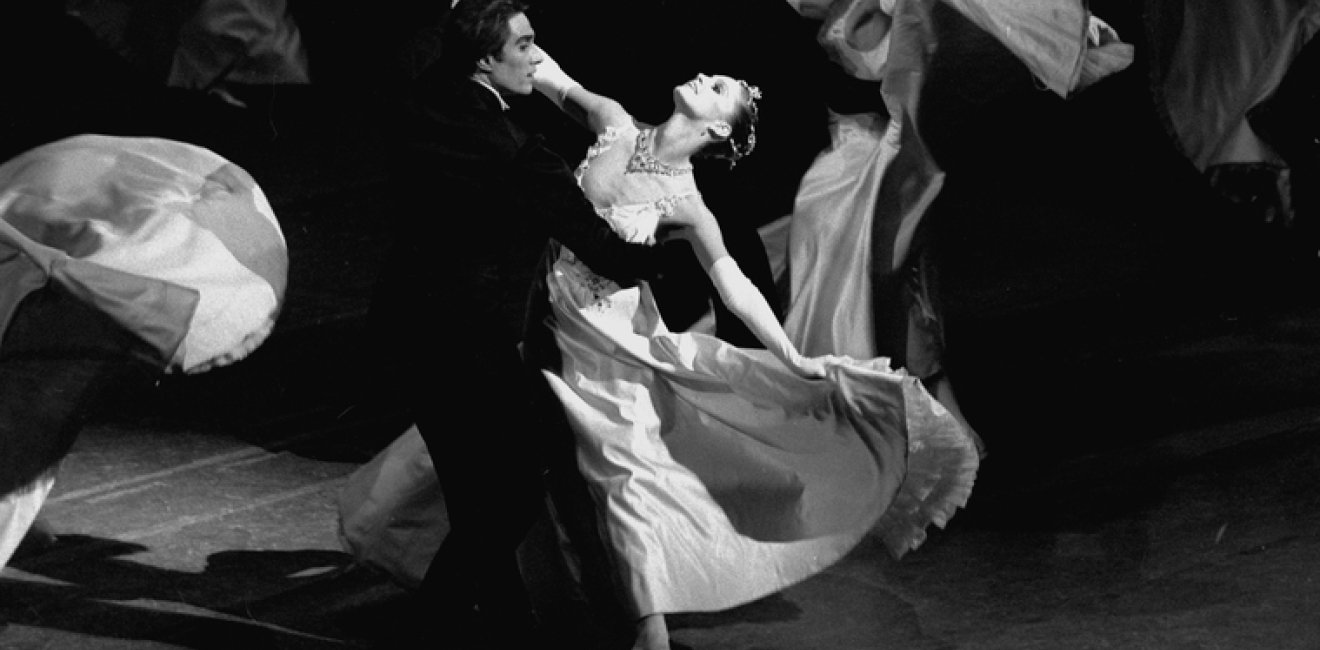
A blog of the Kennan Institute
BY NATALIE ROULAND
This June, the New York City Ballet concluded its 2020–2021 digital season with the Petersburg-born choreographer George Balanchine’s Vienna Waltzes, a singular work that reflects on a singular year. In the year of the COVID-19 pandemic, the fight against systemic racism, and the U.S. Capitol insurrection, ballet companies across the country have struggled not only to survive shuttered theatres and studios but also to prove that ballet remains a viable, vital art form. Viewed against this world-upside-down backdrop, Balanchine’s 1977 ballet assumes a particularly poignant timbre in its testament to grace, civility, and continuity. This late masterwork transports us to bygone eras that are by turn enchanted, tragic, and impossibly glamorous.
At first glance, Vienna Waltzes does not look like a Balanchine ballet. Eschewing the minimalist, neoclassical aesthetic of his “leotard ballets,” Balanchine offers a lavish spectacle with breathtaking scenery by Tiflis-born Rouben Ter-Arutunian and “sumptuous costumes” by Kharkov-born Barbara Karinska. The sylvan set of the Vienna woods literally transforms, as the trees rise magisterially above the stage to form the décor of an Art Nouveau café and the chandeliers of a mirrored ballroom. Yet this “baring of the device,” in which the mechanical movement of the set is visible to the audience, represents Balanchine at his most modern and tracks the history of the waltz from a scandalous folk dance to a “Viennese icon.”
The dancers of Vienna Waltzes display period costumes spanning the gamut from the puffed-sleeve pink dresses and Hussar jackets of the 1814 Congress of Vienna to the bias-cut white evening gowns and tailcoats of the interwar era. Yet, as the New Yorker dance critic Arlene Croce has argued, “the period style . . . is deliberately fantastic,” which draws attention to the artifice of the ballet and marks the work as an elegiac retrospective rather than a simplistic reconstruction.
The dancers primarily wear heeled character shoes, and only one scene, “Voices of Spring,” highlights the virtuoso pointework associated with Balanchine technique. Yet the deep port de bras, elastic backs in the Russian style, and elaborate floor patterns (Croce even called the final “swirling” sequence “a spectacle of controlled hysteria”) all distinguish the choreography as characteristic of Balanchine’s oeuvre.
Even the musical score of Vienna Waltzes departs from Balanchine’s reliance on a signature composer, from his nostalgic interpretations of Piotr Tchaikovsky to his storied collaborations with Igor Stravinsky. In the style of musical pastiche, Vienna Waltzes instead recalls the nineteenth-century practice of compiling a score from the works of multiple composers. Yet Balanchine’s arrangement reveals the arc of Austro-Hungarian and German Romanticism from its apex to its prefiguring of Modernism: the light music of Johann Strauss II (“Tales from the Vienna Woods,” “Voices of Spring,” “Explosion Polka”) acquires more melancholic undertones with Franz Lehár’s “Gold and Silver Waltz” and ascends to frenetic and haunting heights with Richard Strauss’s “First Sequence of Waltzes from Der Rosenkavalier.”
The entire production evokes the Russian imperial ballet tradition inherited by Balanchine and emphasizes Russia’s artistic bond with Europe. Yet Balanchine again hints at a hidden subtext, an alternative story transpiring beneath the glittering façade of the ballet’s surface. While the setting is ostensibly Austria from its imperial origins to its twentieth-century nation-statehood, the ballet assumes a more symbolic meaning when viewed at a temporal and geographic distance—that is to say, almost fifty years after the premiere, eight years after the 2013 production recently livestreamed on the company website, and extracted from its historic home as an exclusively New York City Ballet production.
Unlike other ballets from the Balanchine repertoire that have found temporary homes in other companies and other theatres, Vienna Waltzes retains a proprietary aura. Until last month, you could only experience the magical splendor of Vienna Waltzes at the David H. Koch Theater, which opened in 1964 as the New York State Theater, built to Balanchine’s specifications. The unique challenges of the global pandemic, however, have endowed this work and others with new lives and new audiences, as viewers worldwide tuned in to watch, and rewatch, Balanchine’s homage to the past, and perhaps to his own biography.
The imperial regalia of the first movement evokes not only Central European Romanticism but also the Russian Golden Age, the epoch of Romantic poet Alexander Pushkin and a touchtone for the generation of Russian Modernists, of which Balanchine was a member. The bawdy polka dancers recall not only the dance craze of mid-nineteenth-century Bohemia but also the “polkomania” and boulevard theatre of Paris, where Balanchine auditioned for Sergei Diaghilev’s Ballets Russes and first established himself as a choreographer. The cavalier of the femme fatale “Merry Widow” wears the white-and-red uniform of Austria-Hungary’s last emperor, Franz Joseph I. Yet it is hard not to recall the assassination of his heir presumptive, Archduke Franz Ferdinand, which precipitated World War I and the subsequent assassination of Czar Nicholas II. These two moments of trauma marked Balanchine’s final years in Russia. The final waltz to Der Rosenkavalier conjures up not only an early twentieth-century European ball but also a Hollywood film set, where Balanchine elevated cinematic choreography during the 1930s and 1940s.
Indeed, the culminating mirrored ballroom of Vienna Waltzes calls to mind the midcentury height of Balanchine’s celebrity, another moment in history when television broadcast ballet across state and national boundaries. The “looking glass” of Balanchine’s stage set not only provides a portal back to the imperial origins of dance but also reflects a more democratic vision that endows ballet with a global audience.
Even at its premiere in 1977, Vienna Waltzes was hailed as a blockbuster, a “pop” ballet featuring fifty-five dancers and scaled to the new expansive size of the theater and burgeoning company. Created only six years before Balanchine’s death, Vienna Waltzes also reflects the pensive mood of a master contemplating his legacy. The two ballerinas who framed the original production, Karin Von Aroldingen and Suzanne Farrell, served as the last muses of Balanchine and embodied the bookends of his life in ballet—the delicate charm of Von Aroldingen’s “Girl in Pink” and the unattainable ideal of Farrell’s Art Deco diva. Following her farewell performance of Vienna Waltzes in 1989, Farrell described her melancholic solo as waltzing with the ghost of Balanchine.
Former New York City principal dancer Jacques d’Amboise depicted the harmony and humanity inherent in Balanchine’s lifework: “A visual autobiography, his ballets are a description of himself, with morality and spirituality at their core.” While the Balanchine tradition of ballet as a moral measure of its society has faltered in recent years, the current company has undergone a renascence, as evidenced by its vibrant digital season. And yet this digital season would not have been possible without Balanchine’s commitment to securing a permanent home for his company. While many major companies, including the American Ballet Theatre, depend on shared venues and limited access to filming their performances, the New York City Ballet film archives rival the offerings of major European companies resident in state-supported theaters. Thus the quality of this past year’s digital season is a testament both to the theater itself and to Balanchine’s founding vision.
Over a decade ago, dance critic Jennifer Homans warned that “ballet is dying.” The current pause in the life of the performing arts provides a space for reflecting on the state of this art and its role in the fabric of human history. With its return to stage this fall, Vienna Waltzes offers a way forward: a vision that learns from the lessons of the past while projecting a future that is graceful, resplendent, yet accessible to all.
The opinions expressed in this article are those solely of the authors and do not reflect the views of the Kennan Institute.
Author

Scholar In Residence, The Washington Ballet

Kennan Institute
After more than 50 years as a vital part of the Wilson Center legacy, the Kennan Institute has become an independent think tank. You can find the current website for the Kennan Institute at kennaninstitute.org. Please look for future announcements about partnership activities between the Wilson Center and the Kennan Institute at Wilson Center Press Room. The Kennan Institute is the premier US center for advanced research on Eurasia and the oldest and largest regional program at the Woodrow Wilson International Center for Scholars. The Kennan Institute is committed to improving American understanding of Russia, Ukraine, Central Asia, the South Caucasus, and the surrounding region through research and exchange. Read more

Explore More in The Russia File
Browse The Russia File
Chechnya as a Model of Modern Russia

Russia’s Indigenous Communities and the War in Ukraine

Gas and Power in a Changing US–Russia Relationship

